Puerto Rico Emerges From Hurricane Maria With a Plan and New Hope for Tourism
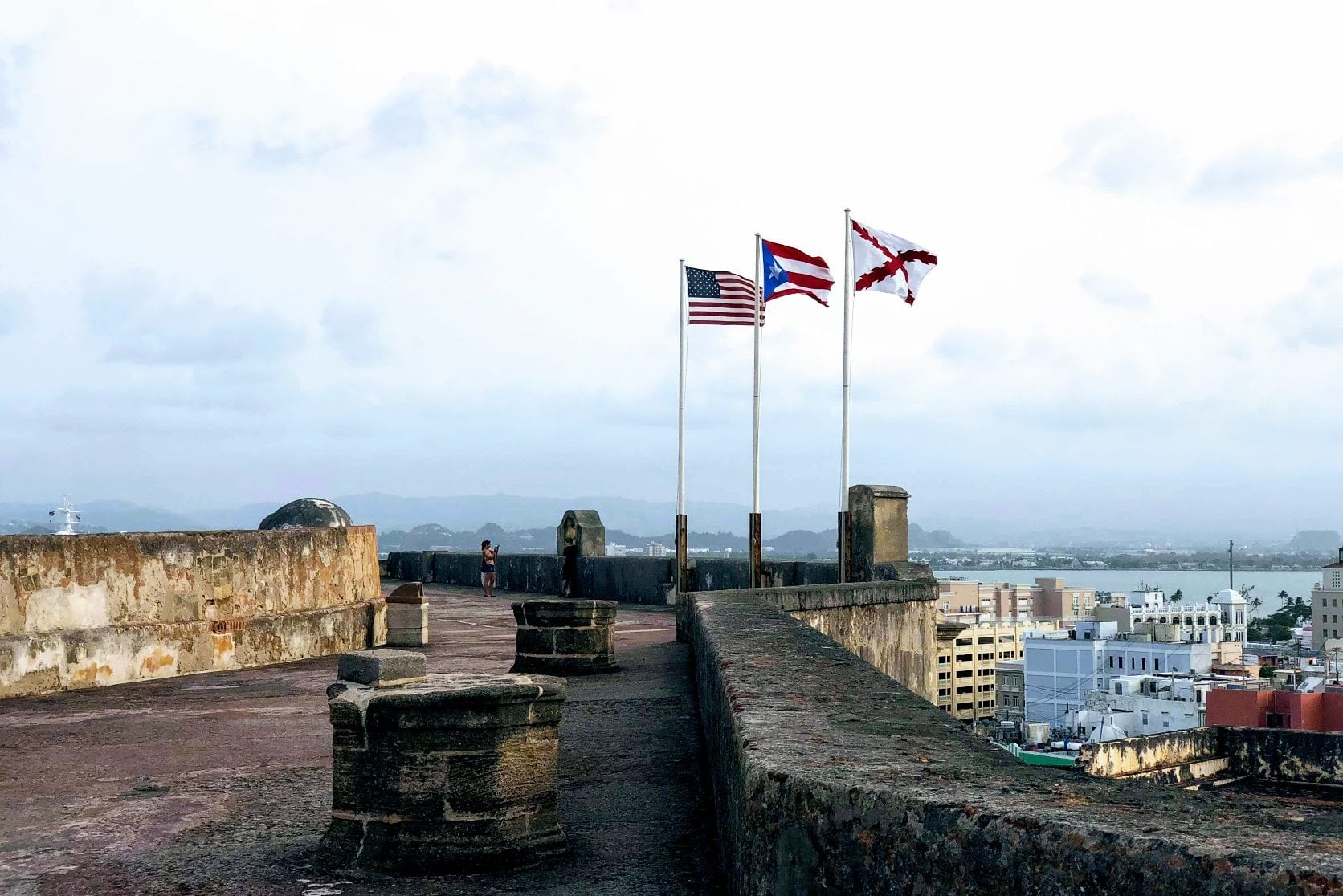
Skift Take
The Skift team stepped off a plane in San Juan, Puerto Rico, in late June for our annual retreat and, like travelers do every day, immediately switched our phones off from airplane mode. After a few seconds, many of us received a message that informed us we could use our phones as we normally would in the mainland United States but on an extended network.
It is a lingering impact of the island’s colonial history in the 21st century, but barely noticeable compared to actual hardships Puerto Rico’s tourism industry is facing.
Our phones were the first of many reminders we would receive of how Puerto Rico, located about 1,000 miles south of Miami and just east of the Dominican Republic, is part of the United States politically and economically. But in other ways, it’s a world away.
We arrived nine months and three days after Hurricane Maria made landfall on the island’s eastern shore. A category four hurricane with 155 mile-per-hour winds, Maria was one of the strongest Atlantic hurricanes on record and one of the deadliest.
Before touching down we saw glimpses of its carnage, blue tarps that covered houses still without roofs. More than 10,000 Puerto Ricans remain without power nearly 10 months after the storm, which completely destroyed the island’s power grid. The island's population has thinned by 200,000 since the storm hit in October — a stunning 6 percent drop — as residents fled the misery, mostly to mainland United States
The lights remain off at many hotels. Of Puerto Rico’s 15,000 rooms, 4,000 rooms (about 27 percent) have been closed for renovations since Maria hit. Many of those renovations are due to the storm, while other hoteliers decided Maria was an opportunity to update their products even if their hotels weren’t badly damaged.
Some 28 hotels are also under construction on the island. While there are no set projections so far, it's clear that tens of millions of dollars in business were wiped from the tourism economy on the island.
Still, with a little coaxing, tourists have started to come back.
Cruise ships were among the first accommodation providers to come back online about three months after Maria. Walking through Old San Juan — which is about as far as many tourists get in Puerto Rico — we saw plenty of cruise passengers milling about in souvenir shops, bars, and taking photos of the colorful colonial buildings that have helped make this a home port of a few Carnival Cruise Line and Royal Caribbean ships.
Cruise ships are a key cog in Puerto Rico’s faltering economic engine, but tourism officials have started to wake up to the reality that cruise passengers aren’t the most lucrative type of visitor – a reality other Caribbean destinations have known for years.
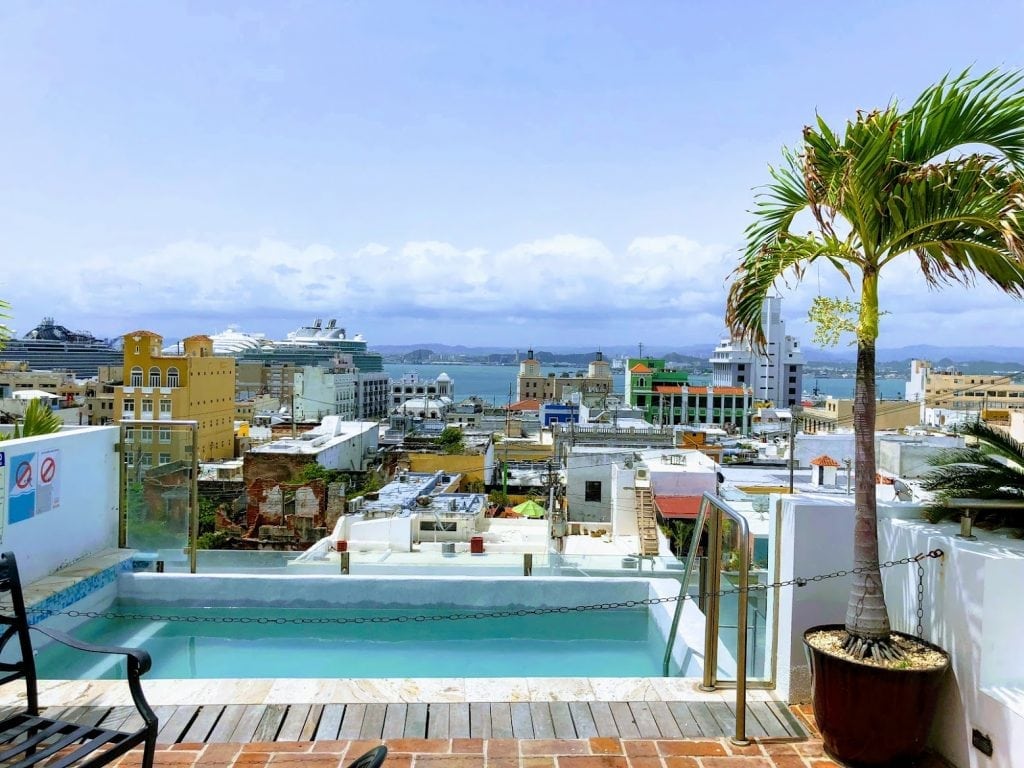
A view of the Port of San Juan from Old San Juan.
Total tourism arrivals have grown nearly 30 percent between 1995 and 2017, from 4 million to 5.2 million, respectively (the later year includes Hurricane Maria). Overnight arrivals have grown nearly 20 percent, from 3.1 million in 1995 to 3.7 million in 2017.
Cruise passenger arrivals have grown nearly 40 percent during the same period, from 956,000 in 1995 to 1.4 million last year.
While the mainland United States began to recover from the global financial crisis in 2011, Puerto Rico’s financial woes continued. The island’s 3.7 million tourist arrivals in 2016 had only recovered to the level they were at in 2008, just before the financial crisis.
"We have been very critical of official numbers in Puerto Rico since we have found huge issues with methodology and processes," said Arnaldo Cruz, director of research & analytics at Foundation for Puerto Rico, who Skift also met in San Juan. The non-profit organization works to support the island’s economic and social development to help grow the visitor economy.
Tourism Growth in Puerto Rico 1995 to 2017
| Year | Total Tourists (Thousands) | Cruise Ship Arrivals (Thousands) | Total Visitor Expenditure (Millions) | Number of Tourist Who Stayed at Hotels (thousands) | Room Inventory (endorsed) |
|---|---|---|---|---|---|
| 1995 | 3,131 | 956 | 1,828 | 810 | 10,251 |
| 1996 | 3,065 | 1,045 | 1,898 | 862 | 10,265 |
| 1997 | 3,242 | 1,108 | 2,046 | 942 | 10,833 |
| 1998 | 3,396 | 1,275 | 2,233 | 1,014 | 11,848 |
| 1999 | 3,024 | 1,197 | 2,139 | 1,042 | 11,102 |
| 2000 | 3,341 | 1,225 | 2,388 | 1,050 | 11,062 |
| 2001 | 3,551 | 1,357 | 2,728 | 1,187 | 11,438 |
| 2002 | 3,087 | 1,277 | 2,486 | 1,148 | 11,759 |
| 2003 | 3,238 | 1,164 | 2,677 | 1,239 | 12,850 |
| 2004 | 3,541 | 1,348 | 3,024 | 1,307 | 12,766 |
| 2005 | 3,686 | 1,387 | 3,239 | 1,362 | 13,336 |
| 2006 | 3,722 | 1,300 | 3,369 | 1,424 | 13,481 |
| 2007 | 3,687 | 1,375 | 3,414 | 1,353 | 13,459 |
| 2008 | 3,716 | 1,497 | 3,535 | 1,343 | 13,311 |
| 2009 | 3,183 | 1,232 | 3,176 | 1,278 | 13,530 |
| 2010 | 3,186 | 1,194 | 3,211 | 1,349 | 13,986 |
| 2011 | 3,048 | 1,166 | 3,143 | 1,409 | 14,335 |
| 2012 | 3,069 | 1,128 | 3,193 | 1,508 | 14,211 |
| 2013 | 3,172 | 1,038 | 3,311 | 1,586 | 14,169 |
| 2014 | 3,246 | 1,210 | 3,439 | 1,635 | 14,766 |
| 2015 | 3,542 | 1,509 | 3,825 | 1,737 | 14,829 |
| 2016 | 3,736 | 1,342 | 3,985 | N/A | N/A |
| 2017 | 3,797 | 1,400 | 4,090 | N/A | N/A |
Source: Puerto Rico Planning Board
Becoming a Global Destination

An abandoned store near the east coast of Puerto Rico, close to where Maria made landfall.
But the financial crisis in Puerto Rico that resulted in the largest municipal bankruptcy in U.S. history and a Zika virus crisis had put a stigma on the island well before Maria that left tourism officials already facing enormous odds.
“It’s not a comeback, it’s a takeover,” said Brad Dean, CEO of the new Discover Puerto Rico tourism board who was hired in March from Myrtle Beach, South Carolina's tourism agency. "The new DMO is one of the many examples of privatization in Puerto Rico.” Dean's wife is Puerto Rican.
For years, Puerto Rico has lagged behind its Caribbean neighbors in visitor arrivals and spending. For the most part, it only has itself to blame, but plans were underway to turn a new leaf before Maria wreaked havoc.
Discover Puerto Rico started operations on July 1, about 16 months after the island’s government passed a law to create it. The organization will handle the leisure and meetings and events marketing of Puerto Rico, while the Puerto Rico Tourism Company, which previously held those responsibilities, will focus on economic development projects for the island.
As Skift previously reported, the tourism company never had consistent branding and messaging because it was pegged to a government that often changed every few years. With each election, newly elected officials had a different idea of how the destination should be sold, and it’s that lack of consistency, said Dean and other officials, that’s held Puerto Rico back.
“A year ago this all seemed very theoretical to make sure all of these synergies are happening,” said Carla Campos, executive director of Puerto Rico Tourism Company, who spoke to Skift in San Juan. “At the tourism company, I need to make sure we grow in terms of lodging offerings such as hotels and Airbnbs. The average visitor is only in the destination for an average of 2.5 days, and our model is not vertically integrated.”
Visitor Expenditure Per Person in 2015, Select Destinations
| Country | Visitor Expenditure Per Person, Per Trip (2015) |
|---|---|
| Panama | $1,990.99 |
| Bahamas | $1,616.17 |
| Colombia | $1,425.45 |
| Costa Rica | $1,250.38 |
| Jamaica | $1,120.58 |
| The Dominican Republic | $1,092.50 |
| Puerto Rico | $1,079.90 |
| Cuba | $678.03 |
But if Puerto Rico wants to truly dominate Caribbean tourism and compete on the global level, it will take more than a new tourism board to accomplish.
The island wants to be an aspirational destination that millions of people long to visit, rather than an afterthought. But it doesn’t have the geography that Iceland, for example, has as a logical stopover point between two continents. It hasn’t been able to attract the kind of foreign investment that Jamaica or Cuba have garnered.
Puerto Rico’s 15,000 hotel rooms are also paltry compared to more than 30,000 rooms and counting in both Jamaica and the Dominican Republic. The island’s hotel inventory has grown about 44 percent in the last 20 years, but nearby destinations grew more because foreign investors saw more potential.
“A lot of hotels that had unions affiliated with them closed for a while,” said Campos. “Those union workers are now free agents in the workforce and hotels are able to hire based on the expertise required.”
And, with its bankruptcy, the island has been in a financial rut for decades that it’s still struggling to break out of.
Puerto Rico’s Recent History
Section 936, a U.S. law enacted in 1976, allowed U.S. manufacturing companies to avoid corporate income taxes on profits made in U.S. territories, including Puerto Rico. Manufacturers set up shop across the island en masse that led to a boom generation, led by big pharmaceutical companies.
Many Puerto Ricans point to 1996, the year that President Bill Clinton signed a law that would phase out Section 936, as the moment that began the island’s downfall into financial crisis. Fast forward to 2018 and the island is nearly $70 billion in debt. More than 163,000 jobs were lost between 2007 and 2017 and Puerto Rico’s population has dropped from 3.7 million in 2010 to about 3.4 million last year before Maria (an 8 percent decrease).
Some estimates also put Puerto Rico’s death toll from Maria at more than 4,000, while more than 200,000 fled to the U.S. mainland after the storm and haven’t returned. As U.S. citizens, Puerto Rico’s residents can move freely between the island and the mainland.

Source: Foundation for Puerto Rico
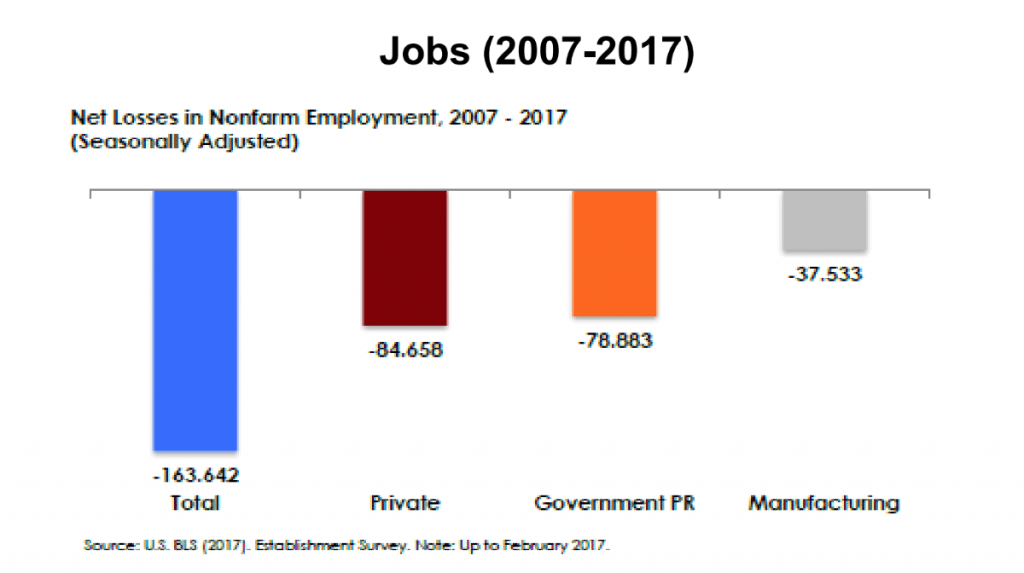
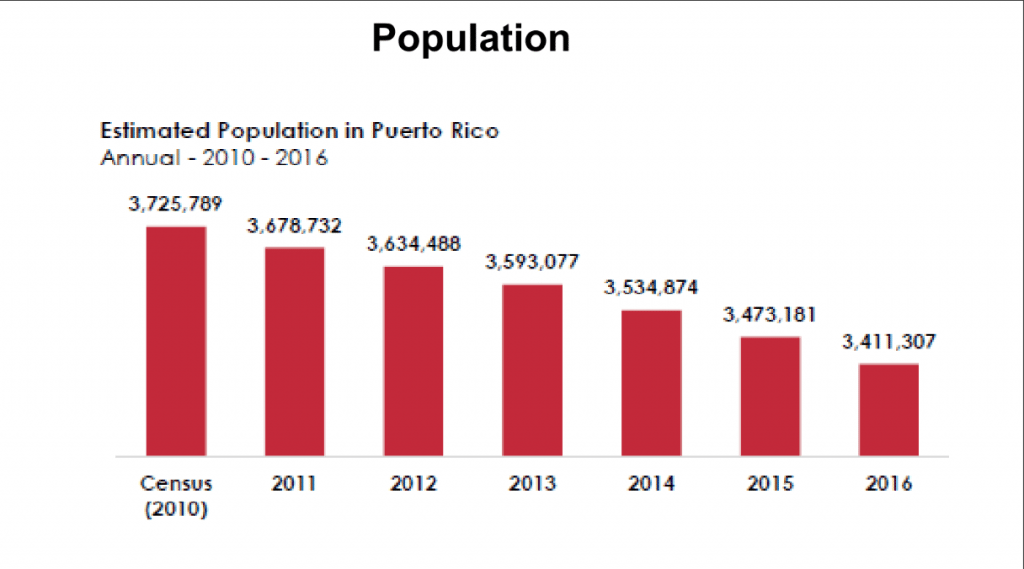
Source: U.S. Census data
Tourism Budget Windfall
The new tourism board’s budget — $25 million — stands among some of the most well-funded U.S. state tourism budgets. If Puerto Rico was a state, it would rank among the top 10 most well-funded state tourism budgets and its budget is also above the average state budget of about $20 million.
It wasn’t easy to get the money, and tourism officials tell tales of battling the island’s government for years to get to that level and secure a new tourism board. But now that it has all this cash and can leave the destination recovery component to the tourism company, expectations are high that it will build a brand that will become a household name.
The tourism board said that 70 percent of its budget will go towards sales, marketing, and promotion expenses. It cited a 2017 Destinations International study that found, on average, many U.S. tourism boards allocate 48 percent of their budgets to sales, marketing, and promotion expenses.
Tourism boards around Puerto Rico’s size with budgets between $20 and $30 million typically allocate 58 percent of their budgets to sales, marketing, and promotion expenses.
Brand USA, the national organization responsible for promoting the entire United States to international visitors, is also helping promote the island without contributions that it typically requires from destinations that want to leverage its services. This is part of what the organization does to support destinations in recovery, said Anne Madison, chief strategy and communications officer for Brand USA.
Christina Vazquez, who owns a water sports and eco-tours business at Humacao Nature Reserve in Puerto Rico, where Skift spent a day planting trees, said she’s met with the new tourism board but isn’t sure how they plan to promote her business and the reserve.
“They have to know what they’re promoting and what we have all across the island,” said Vazquez. “Let’s see how they’ll do it.
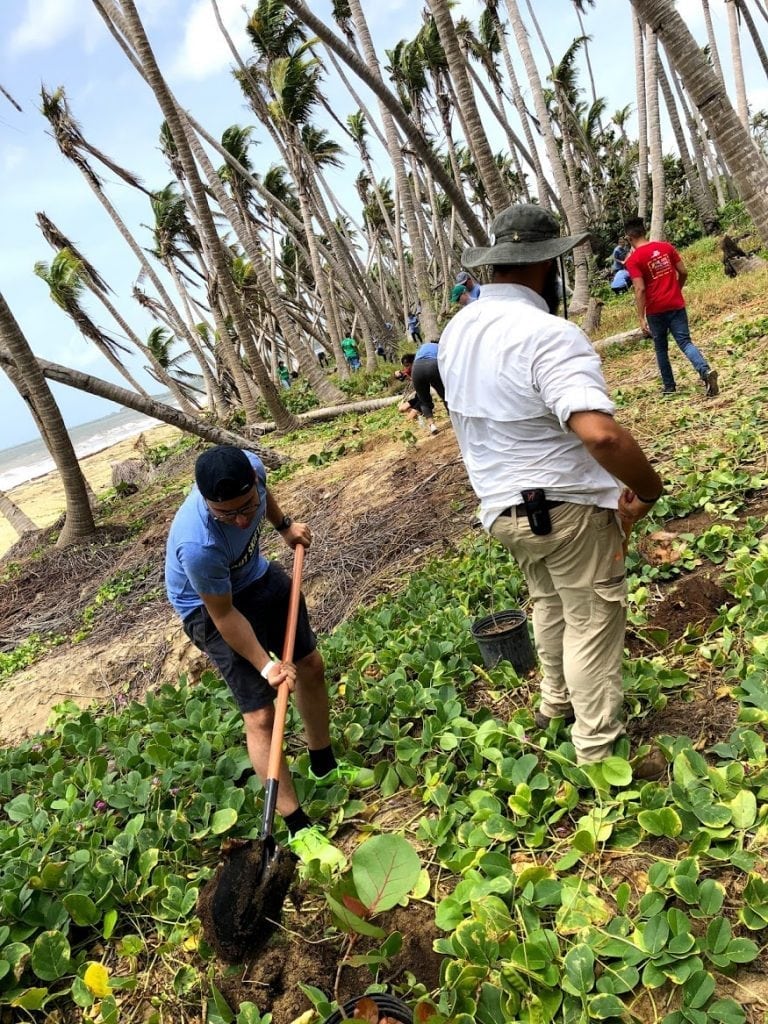
The Skift team planting trees at Humacao Nature Reserve. The thinned tops of the palm trees show the devastation from Maria.
Dean said in meeting with various groups in recent months, he and his newly assembled team have realized they hadn’t considered themes like wildlife in marketing the island’s uniqueness.
Puerto Rico has an island just offshore called Monkey Island where primates abound, but most visitors don’t realize it’s easily within reach.
It’s clear that while the tourism board has a healthy budget to work with, it’s challenge is actually what to use it for, and what it should focus on. Puerto Rico has an embarrassment of riches in terms of tourist attractions and is a mature destination, yet its startup tourism board is looking at the island with completely new eyes.

Source: Puerto Rico Destination Marketing Organization and Destinations International
Changing the Local Tourism Industry
Tourist attractions like El Yunque National Forest are getting back to normal but there’s a sense across the island that attractions, hotels, and restaurants can’t reopen with a pre-Maria mindset.
For many in the local tourism industry, Maria’s winds blew in the realization that a tradition of hospitality like other Caribbean destinations have developed can’t remain non-existent.
"An entrepreneurial mindset was not prevalent in Puerto Rico in previous generations but many NGOs have been working very hard to cultivate that entrepreneurial spirit for the past 10 to 15 years but it is a relatively young generation of entrepreneurs," said Maria Jaunarena, executive vice president of the foundation. "This is why Foundation for Puerto Rico focused its efforts on supporting them because they are vulnerable but essential for Puerto Rico’s recovery and transformation."
The foundation gave resiliency kits to small businesses across Puerto Rico impacted by Maria, which included satellite Wi-Fi, water filters, and solar lighting. “When the next storm comes, these businesses will have the basics to get back up and running after the storm passes,” said Annie Mayol, president and chief operating officer of the foundation.
We visited the western half of the island one day and stopped at a statue of Christopher Columbus in Arecibo called “Birth of a New World.” We had no idea this statue existed and immediately set out to climb a hill that led to the base. But to our dismay, there was no parking for the statue and no obvious road or trail to take to reach the base. There were no signs or visitor centers that offered information for what the statue was.
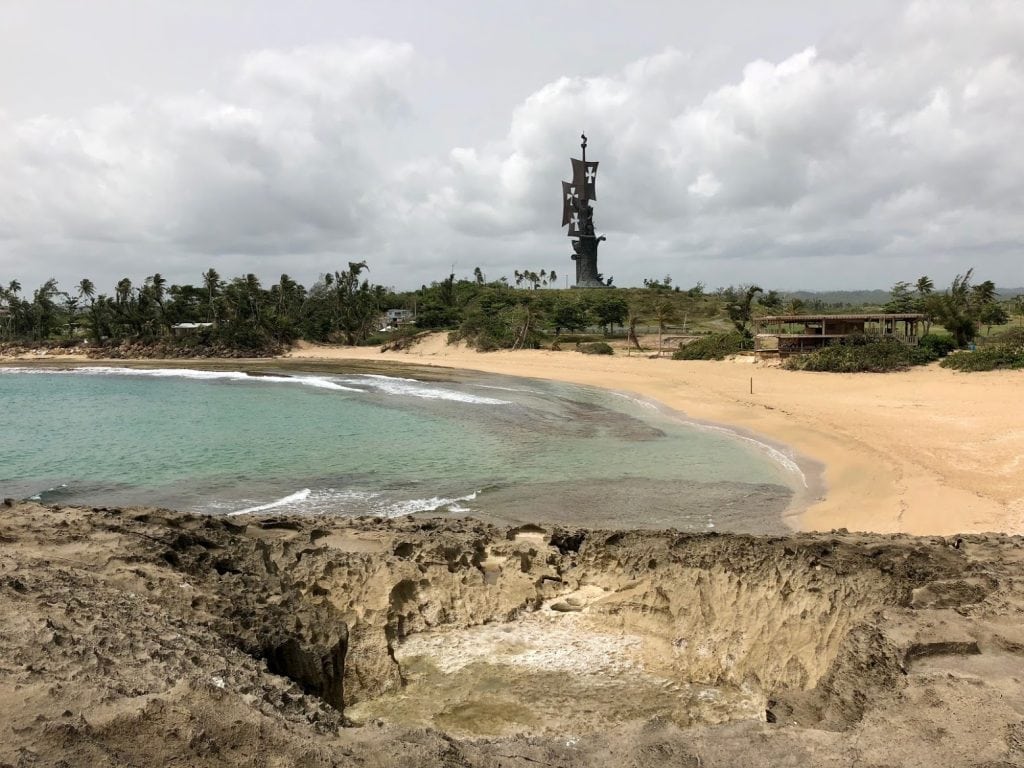
A view of the Christopher Columbus statue in Arecibo, Puerto Rico.
As we made our way closer, a truck emerged from a road leading from the other side of the hill and the driver informed us that this was private property and that we had to leave and couldn’t take photos.
We were amazed that, what we learned after the fact is clearly an iconic Puerto Rican attraction, had no visitor infrastructure and was closed to the public.
Further along our journey to the Aguadilla on the west coast, we stopped at a beach with cliffs, caves, and some kind of hieroglyphics carved into a few rocks. This attraction was also located on private property, but the owner was present at a gateway where you pay $5 per person to enter and there are parking and restrooms available.
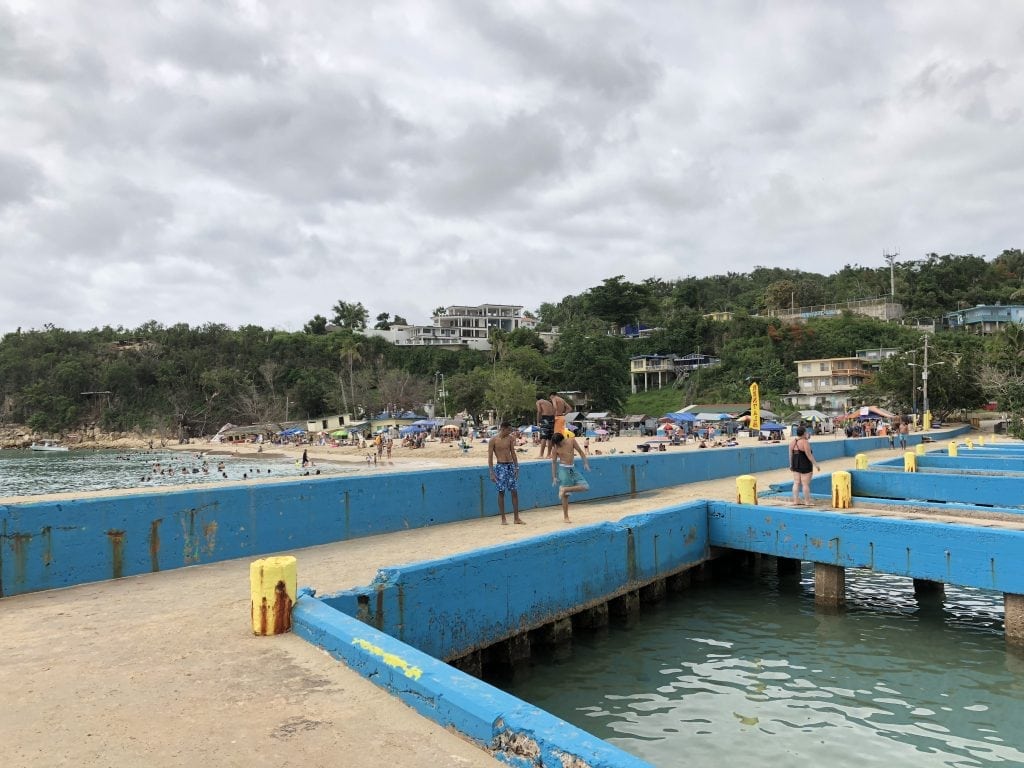
Crash Boat Beach in Aguadilla, Puerto Rico.
It’s clear that once the tourism board identifies new attractions it wants to market, it will need to work with the local government and property owners to build basic tourism infrastructure for some attractions before they’re tourism ready.
The foundation launched the VIEWPR database a few years ago that it updates with current information about attractions and uses as a central repository for research on the visitor economy, and it hopes more members of the island’s tourism industry contribute to it.
New Opportunities
One area the foundation and tourism board plan to focus on are getting more student and youth groups to choose Puerto Rico over other popular beach destinations like Costa Rica.
“Costa Rica is completely oversold and the Student Youth Travel Association is eager to get more student groups into Puerto Rico,” said Leah Chandler, chief marketing officer of the tourism board. “There is going to be a significant investment in connecting with those tour operators and student groups.”
The Student Youth Travel Association and other organizations such as Your Big Year told Skift they’re planning to bring more student groups to the island in the coming year.
The foundation, which served as the temporary headquarters for many NGOs and government agencies because it was one of the only large buildings in San Juan with power and Wi-Fi immediately after Maria, is working with a handful of communities across the island in its Bottom Up Destination Recovery Initiative to spur job creation and restore businesses like local museums that will help jumpstart the local economy.
While some tourism officials told Skift the island has largely moved beyond the need for disaster recovery voluntourism projects, there’s no question that parts of the island are still in bad shape. Tropical Storm Beryl, one of the first named storms of the 2018 Atlantic hurricane season, passed through the island earlier this week and knocked out power to another 20,000 residents.
Some residents are also about to lose backup generator power that they’ve been living on since Maria, and the CEO of the Puerto Rico Electric Power Authority resigned this week after only four months on the job.
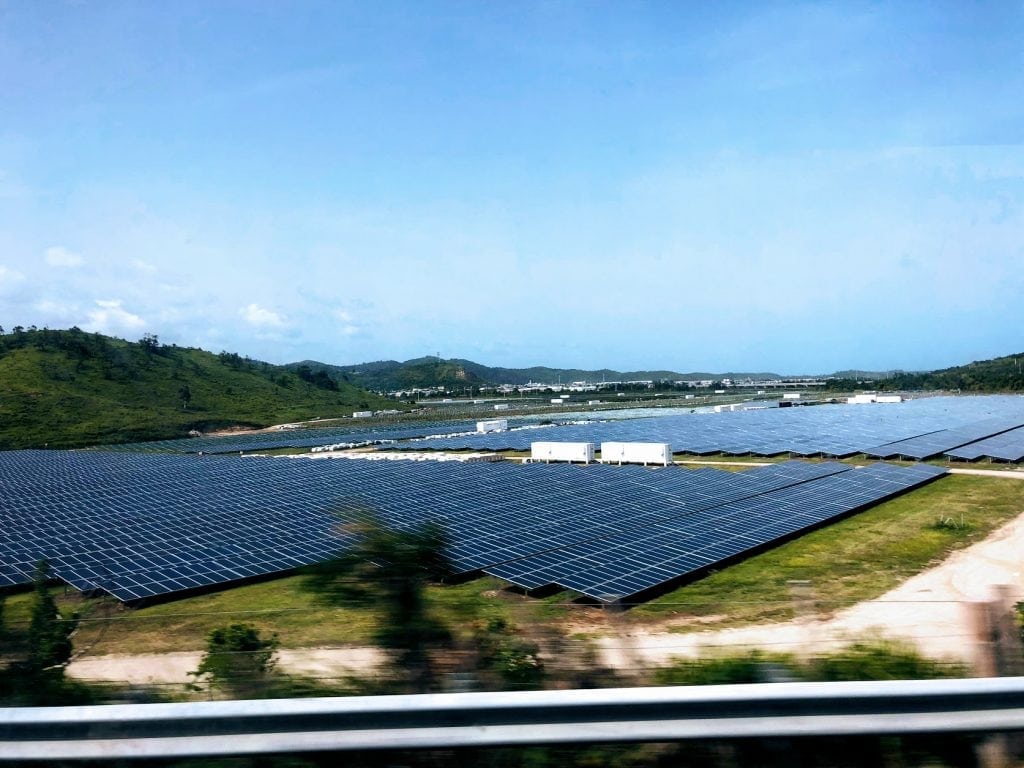
A solar panel farm we passed on the east side of Puerto Rico. Part of the solar field was destroyed by Maria.
A federal judge also extended FEMA aid for Maria evacuees this week after 2,000 people in the Temporary Shelter Assistance program were set to lose their housing this month. The program has given housing to those whose homes were badly damaged or destroyed by the storm.
There’s a fine line that Puerto Rico is walking – between caring for a population that’s largely struggling and a government with ambitions to be a global destination. Both sides can complement each other and lead to job creation and benefit the local population, and many other destinations have walked this line before.
From Skift’s visit, we learned that there’s certainly a will to make sure that this time around change isn’t just a buzzword that gets budgets passed and quotas met, but tourism officials are still figuring out the way forward.
Update: Discover Puerto Rico CEO Brad Dean announced the name of the new tourism board this week at the Destinations International Annual Convention in Anaheim, California.
Videos shot and produced by Richard Chen.




